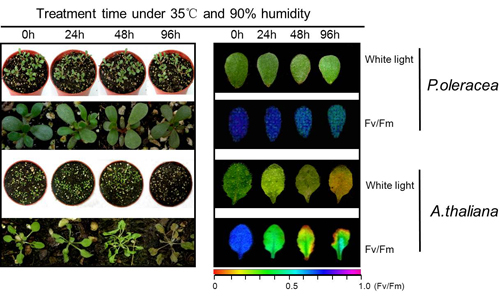High temperature and high humidity typically are characterized as independent abiotic stress conditions. An understanding of the mechanisms underlying plant tolerance to high temperature and humidity may facilitate the development of cultivars adaptable to warm or humid regions.
HU Xiangyang’s group from Kunming Institute of Botany applied physiological and comparative proteomics to investigate the mechanisms underlying Portulaca oleracea’s tolerance of high-temperature and high-humidity stress. Under conditions of 90% humidity and 35°C, the thermotolerant plant P. oleracea exhibits excellent photosynthetic capability and relatively little oxidative damage. In this research, a proteomic approach was performed to determine the proteomic response that occurs in leaves of P. oleracea following exposure to high temperature and high humidity.
A total of fifty-one differentially expressed proteins were detected and characterized functionally and structurally, these identified proteins were involved in various functional categories, mainly including material and energy metabolism, the antioxidant defense responses, protein destination and storage, and transcriptional regulation. The subset of antioxidant defense-related proteins demonstrated marked increases in activity with exposure to heat and humidity, which led to lower accumulations of H2O2 and O2- in P. oleracea compared with the thermosensitive plant Arabidopsis thaliana. The quickly accumulations of proline content and heat-shock proteins, and depleting abscisic acid (ABA) via increasing ABA-8’-hydroxylase were also found in P. oleracea under stress conditions, that resulted into greater stomata conductance and respiration rates. Based on these findings, we propose that P. oleracea employs multiple strategies to enhance its adaptation to high-temperature and high-humidity conditions.
This work is online published by Journal of Proteome Research (http://pubs.acs.org/doi/abs/10.1021/pr300027a), and supported by 100 Talents Program of the Chinese Academy of Sciences and by grants from the National Science Foundation of China.

Responses of P. oleracea and A. thaliana to combined high-temperature and high-humidity stressors. (Image by KIB)




